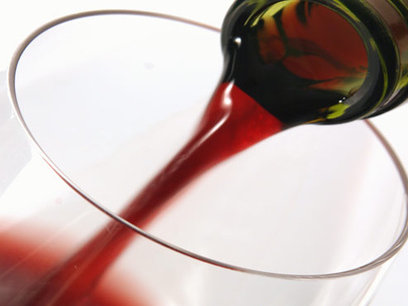I am going to come out right from the start and say that some of you reading this column might bristle at what I am about to say. Sometimes the things that make you go "Hmmm" are most entertaining. Think of all the silly drama that's on TV -- "Rock of Love," "Real Housewives of New York City," even the ever-loved "American Idol." The "are you serious?" factor is what keeps us glued.
This column is going to elicit some of those "are you for real?" feelings, but just like the "reality" of the aforementioned shows, it will inevitably keep you fixed.
The best way to start is a premise that will elicit a good response. Ready?
If you think you have a sulfite allergy when it comes to wine, you are ALMOST CERTAINLY WRONG!
I'm here to help, not just throw exclamation points about, but the reality of a true sulfite allergy is that it is every bit as severe as an allergy to peanuts or strawberries or shellfish.
The FDA has determined that the percentage of the population that suffers from a true sulfite allergy is less that one half of one percent of the gross population of the United States. According to the U.S. Census Bureau at the time of this writing, there are more than 306 million people in the country. (Population increases an average of one person every 12 seconds) That means that 1 percent is just more than 3 million. And one half of that equals 1.5 million. It's not very likely that one of those is you.
In order to quell your rising indignance, let me go over a few points to help expose the myths that have led people to believe that they are truly allergic to sulfites.
1. What are sulfites?
Sulfite is a word used to describe forms of sulfurous acid, including sulfur dioxide. Sulfur dioxide has been used as a preservative and anti-microbial for hundreds of years. Sulfites are found naturally in grape skins, fruit and produce, and the human body produces 1 gram per day. Sulfur dioxide is added to almost all wines in order to prevent bacteria from ruining the wine. Even if sulfur dioxide wasn't added, sulfites are a natural byproduct from yeast during the fermentation process. Sulfites are also prevalent in dried and processed food, produce and pharmaceuticals.
2. What constitutes an actual sulfite allergy?
Typical sulfite sensitivity will cause a visible rash and severe itching, swelling, flushing and difficulty breathing. Moreover, those who are legitimately allergic to sulfites often suffer anaphylaxis (you can't breathe at all) and have most certainly known this since they were young. Consequently, allergists treat severe sulfite allergies similar to peanut allergies that may cause anaphylactic shock. But again, those individuals likely have had reactions since they were young and stay well clear of anything containing sulfites.
If sulfites can cause an allergic reaction it only seems appropriate to warn the wine consumer -- right?
Right now the FDA has determined that a wine containing less than 10 milligrams per liter of sulfites may be declared "Sulfite Free." Any wines containing more (an average bottle contains 80 mg per liter) must carry the label "Contains Sulfites." I know you are reading the last sentence thinking that if you drink the "Sulfite Free" wine, you won't have a reaction. That might be true if anyone actually knew what quantity of sulfites need to be present to cause an allergic reaction. Since no one has determined what quantity this is, how do we know if even the smallest amount of sulfites will cause a reaction? Could it be one milligram per liter? How about two? There is no such thing as a sulfite-free wine.
3. If no one knows, then why "Sulfite-Free Wine?"
Why does the U.S. (and only the U.S.) require wines with more than 10 mg/liter of sulfites to place what amounts to a warning label on the front?
No one really seems to have the answer for that, either. What I can tell you will shock you to your very core, much like Milwaukee's dismay when Danny Gokey was voted off the top three on "Idol."
The FDA rates wine and food completely differently in this country, so -- are you ready for this? -- a 2-ounce portion of dried apricots contains the same level of sulfites as a glass of wine.
What about that prescription you picked up after your last doctor visit? It is loaded with sulfur dioxide to maintain freshness.
Why don't you hear about sulfites in all these food products? And why doesn't this columnist stop asking so many questions without providing any answers?
Well, I'm not sure on either, but what would a good reality show be without the suspense? But keep reading, and I will tell you why the red wines have been giving you a headache and what you can do to fix it.
4. Why can I drink white wine and not red? Why does red wine give me a headache?
One of the most common misperceptions I have encountered, at least in relation to sulfites in wine, concerns those who claim that they can drink white wine, but not red wine due to the sulfite content.
While it is true that reds possess more natural sulfites, white wines require the addition of considerably higher levels of sulfur dioxide in order to maintain freshness. For the record, white wines, particularly sweet whites, contain up to 10 times the level of sulfites as reds. And sulfites have nothing to do with headaches.
So what is it about red wines that cause so many allergic reactions / headaches? There are actually several factors that have been studied.
The first and most common are histamines. Histamines are found in nature in many forms including plant matter, i.e. grapes, and cause those susceptible to suffer from sinus issues. Since pollen and other goodies are trapped on the surface of the grape -- the skins -- and only red wines come in contact with the skins, it stands that those who are sensitive to histamines will be affected when they drink red wine.
Histamines can be up to 200 percent higher in reds than in whites. There is home remedy or wives' tale that dictates drinking a cup of black tea before consuming red wine. The compound quercetin found in black tea has been thought to inhibit the flushing effects of histamines, but this has not been studied extensively. The tried-and-true method is to take an over-the-counter antihistamine like Benedryl or Zyrtec. But, make sure you choose the non-drowsy variety or you may fall asleep in the middle of your toast to good red wine.
The second factor is tannin. Tannins in red wines can cause the release of small levels of serotonin in the brain, affecting those prone to migraines. But several Harvard studies have shown that those not prone to migraines did not get headaches from increased levels of tannin.
Prostaglandins are the third factor studied. Prostaglandins are substances that cause pain and swelling. When combined with the dehydrating properties of alcohol, have been thought to increase the likelihood of headaches when drinking red wine. The biochemistry behind this one is quite a bit more detailed, so I won't bore you with the details, but prostaglandins are everywhere. If you are particularly sensitive, then taking Ibuprofen, which is a prostaglandin inhibitor, may be helpful.
The fourth factor has not been studied, at least in any respectable research setting, but is a theory of mine. Cheap wine is the fourth factor. I am convinced that poorly-made wine contains more unbalanced bacteria, junk, stems, snakes and bugs and who-only-knows-what, that it's no wonder people get headaches from it. In order to make quality wine, a winemaker has to invest in quality production. No way can a $2 bottle of wine be made well. Since there is not a stitch of empirical evidence, feel free to scoff at me and love to hate me just like you did Stefan from last season's "Top Chef." And if you want to talk more on this topic, I can go for miles more than this column permits.
So, what does all this mean for the average wine drinker plagued by headaches?
Unless you have been packing an Epi-Pen for years, we know you don't have a sulfite allergy. So here is what you can do:
Hydration is key. An 8-ounce glass of water with every glass of wine will do wonders.
Eat before you drink. Americans are terrible at binging on empty stomachs during the weekend. Enjoy your wine with food, or at least have something in your stomach before you get started.
Take a pill. Over-the-counter antihistamines work great. Take a Zyrtec about and hour before you plan on drinking, especially if you have other seasonal or animal type allergies.
Drink quality wine. Remember, though, that quality doesn't have to mean expensive.
Read the label. The alcohol content in wine can kill you. A lot of New World producers make some big wines with 15 percent alcohol and higher. Those will do a lot more toward dehydration and hangover than lower alcohol wines.
Exercise moderation. Drinking too much will give you a headache, regardless of what color the wine is.
Have fun, when in doubt consult a physician, and we'll see you next week.




.jpeg)
.jpeg)

